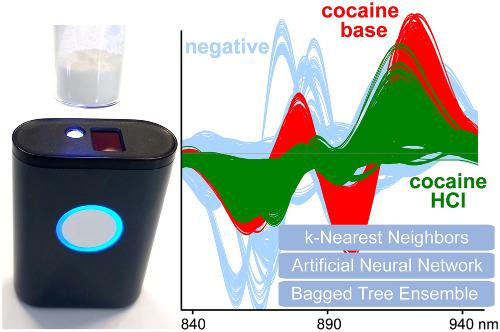当前位置:
X-MOL 学术
›
Drug Test. Anal.
›
论文详情
Our official English website, www.x-mol.net, welcomes your feedback! (Note: you will need to create a separate account there.)
Rapid and robust on-scene detection of cocaine in street samples using a handheld near-infrared spectrometer and machine learning algorithms.
Drug Testing and Analysis ( IF 2.9 ) Pub Date : 2020-07-07 , DOI: 10.1002/dta.2895 Ruben F Kranenburg 1, 2 , Joshka Verduin 1, 2 , Yannick Weesepoel 3 , Martin Alewijn 3 , Marcel Heerschop 4 , Ger Koomen 4 , Peter Keizers 5 , Frank Bakker 5 , Fionn Wallace 6 , Annette van Esch 6 , Annemieke Hulsbergen 6 , Arian C van Asten 2, 7
Drug Testing and Analysis ( IF 2.9 ) Pub Date : 2020-07-07 , DOI: 10.1002/dta.2895 Ruben F Kranenburg 1, 2 , Joshka Verduin 1, 2 , Yannick Weesepoel 3 , Martin Alewijn 3 , Marcel Heerschop 4 , Ger Koomen 4 , Peter Keizers 5 , Frank Bakker 5 , Fionn Wallace 6 , Annette van Esch 6 , Annemieke Hulsbergen 6 , Arian C van Asten 2, 7
Affiliation

|
On‐scene drug detection is an increasingly significant challenge due to the fast‐changing drug market as well as the risk of exposure to potent drug substances. Conventional colorimetric cocaine tests involve handling of the unknown material and are prone to false‐positive reactions on common pharmaceuticals used as cutting agents. This study demonstrates the novel application of 740–1070 nm small‐wavelength‐range near‐infrared (NIR) spectroscopy to confidently detect cocaine in case samples. Multistage machine learning algorithms are used to exploit the limited spectral features and predict not only the presence of cocaine but also the concentration and sample composition. A model based on more than 10,000 spectra from case samples yielded 97% true‐positive and 98% true‐negative results. The practical applicability is shown in more than 100 case samples not included in the model design. One of the most exciting aspects of this on‐scene approach is that the model can almost instantly adapt to changes in the illicit‐drug market by updating metadata with results from subsequent confirmatory laboratory analyses. These results demonstrate that advanced machine learning strategies applied on limited‐range NIR spectra from economic handheld sensors can be a valuable procedure for rapid on‐site detection of illicit substances by investigating officers. In addition to forensics, this interesting approach could be beneficial for screening and classification applications in the pharmaceutical, food‐safety, and environmental domains.
中文翻译:

使用手持式近红外光谱仪和机器学习算法快速、稳健地现场检测街道样本中的可卡因。
由于快速变化的毒品市场以及暴露于强效药物的风险,现场毒品检测是一项日益重大的挑战。传统的比色可卡因测试涉及处理未知材料,并且容易对用作切割剂的常见药物产生假阳性反应。本研究展示了 740-1070 nm 小波长范围近红外 (NIR) 光谱的新应用,可自信地检测病例样本中的可卡因。多阶段机器学习算法用于利用有限的光谱特征,不仅预测可卡因的存在,还预测浓度和样品组成。基于来自病例样本的 10,000 多个光谱的模型产生了 97% 的真阳性和 98% 的真阴性结果。模型设计中未包含的 100 多个案例样本显示了实际适用性。这种现场方法最令人兴奋的方面之一是,该模型通过使用后续验证性实验室分析的结果更新元数据,几乎可以立即适应非法药物市场的变化。这些结果表明,应用于经济型手持式传感器的有限范围 NIR 光谱的先进机器学习策略可以成为调查人员快速现场检测非法物质的宝贵程序。除了法医学,这种有趣的方法可能有益于制药、食品安全和环境领域的筛选和分类应用。这种现场方法最令人兴奋的方面之一是,该模型通过使用后续验证性实验室分析的结果更新元数据,几乎可以立即适应非法药物市场的变化。这些结果表明,应用于经济型手持式传感器的有限范围 NIR 光谱的先进机器学习策略可以成为调查人员快速现场检测非法物质的宝贵程序。除了法医学,这种有趣的方法可能有益于制药、食品安全和环境领域的筛选和分类应用。这种现场方法最令人兴奋的方面之一是,该模型通过使用后续验证性实验室分析的结果更新元数据,几乎可以立即适应非法药物市场的变化。这些结果表明,应用于经济型手持式传感器的有限范围 NIR 光谱的先进机器学习策略可以成为调查人员快速现场检测非法物质的宝贵程序。除了法医学,这种有趣的方法可能有益于制药、食品安全和环境领域的筛选和分类应用。这些结果表明,应用于经济型手持式传感器的有限范围 NIR 光谱的先进机器学习策略可以成为调查人员快速现场检测非法物质的宝贵程序。除了法医学,这种有趣的方法可能有益于制药、食品安全和环境领域的筛选和分类应用。这些结果表明,应用于经济型手持式传感器的有限范围 NIR 光谱的先进机器学习策略可以成为调查人员快速现场检测非法物质的宝贵程序。除了法医学,这种有趣的方法可能有益于制药、食品安全和环境领域的筛选和分类应用。
更新日期:2020-07-07
中文翻译:

使用手持式近红外光谱仪和机器学习算法快速、稳健地现场检测街道样本中的可卡因。
由于快速变化的毒品市场以及暴露于强效药物的风险,现场毒品检测是一项日益重大的挑战。传统的比色可卡因测试涉及处理未知材料,并且容易对用作切割剂的常见药物产生假阳性反应。本研究展示了 740-1070 nm 小波长范围近红外 (NIR) 光谱的新应用,可自信地检测病例样本中的可卡因。多阶段机器学习算法用于利用有限的光谱特征,不仅预测可卡因的存在,还预测浓度和样品组成。基于来自病例样本的 10,000 多个光谱的模型产生了 97% 的真阳性和 98% 的真阴性结果。模型设计中未包含的 100 多个案例样本显示了实际适用性。这种现场方法最令人兴奋的方面之一是,该模型通过使用后续验证性实验室分析的结果更新元数据,几乎可以立即适应非法药物市场的变化。这些结果表明,应用于经济型手持式传感器的有限范围 NIR 光谱的先进机器学习策略可以成为调查人员快速现场检测非法物质的宝贵程序。除了法医学,这种有趣的方法可能有益于制药、食品安全和环境领域的筛选和分类应用。这种现场方法最令人兴奋的方面之一是,该模型通过使用后续验证性实验室分析的结果更新元数据,几乎可以立即适应非法药物市场的变化。这些结果表明,应用于经济型手持式传感器的有限范围 NIR 光谱的先进机器学习策略可以成为调查人员快速现场检测非法物质的宝贵程序。除了法医学,这种有趣的方法可能有益于制药、食品安全和环境领域的筛选和分类应用。这种现场方法最令人兴奋的方面之一是,该模型通过使用后续验证性实验室分析的结果更新元数据,几乎可以立即适应非法药物市场的变化。这些结果表明,应用于经济型手持式传感器的有限范围 NIR 光谱的先进机器学习策略可以成为调查人员快速现场检测非法物质的宝贵程序。除了法医学,这种有趣的方法可能有益于制药、食品安全和环境领域的筛选和分类应用。这些结果表明,应用于经济型手持式传感器的有限范围 NIR 光谱的先进机器学习策略可以成为调查人员快速现场检测非法物质的宝贵程序。除了法医学,这种有趣的方法可能有益于制药、食品安全和环境领域的筛选和分类应用。这些结果表明,应用于经济型手持式传感器的有限范围 NIR 光谱的先进机器学习策略可以成为调查人员快速现场检测非法物质的宝贵程序。除了法医学,这种有趣的方法可能有益于制药、食品安全和环境领域的筛选和分类应用。



























 京公网安备 11010802027423号
京公网安备 11010802027423号